Click on images to enlarge
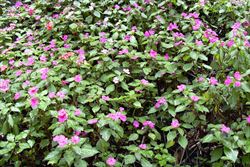
dense infestation (Photo: Forest and Kim Starr, USGS)
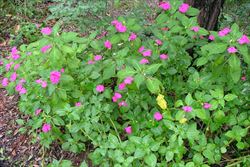
habit (Photo: Sheldon Navie)
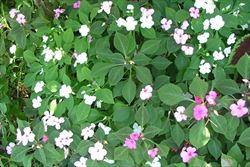
habit (Photo: Sheldon Navie)
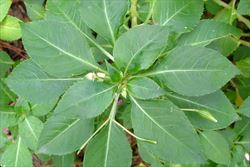
leaves (Photo: Sheldon Navie)
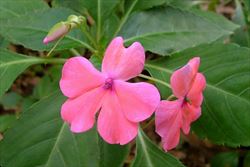
flowers (Photo: Sheldon Navie)
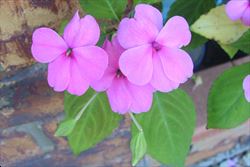
flowers and immature fruit (Photo: Sheldon Navie)
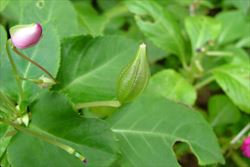
close-up of flower bud, showing spur and keeled upper petal, and young fruit (Photo: Sheldon Navie)

seedlings and young plants (Photo: Sheldon Navie)
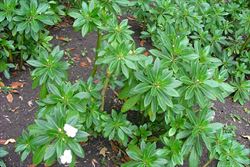
habit of shrub balsam, Impatiens sodenii (Photo: Sheldon Navie)
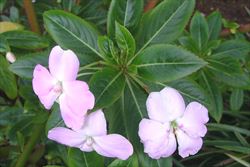
flowers and stalkless leaves of shrub balsam, Impatiens sodenii (Photo: Sheldon Navie)
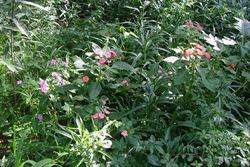
infestation along Enoggera Creek at The Gap in Brisbane (Photo: Sheldon Navie)
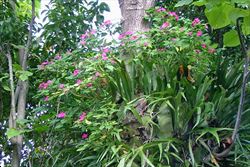
growing as an epiphyte on a tree (Photo: Sheldon Navie)
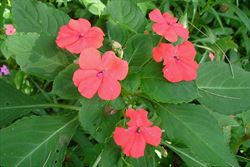
flowers (Photo: Sheldon Navie)
Scientific Name
Impatiens walleriana Hook. f.
Synonyms
Impatiens sultani Hook. f.Impatiens wallerana Hook. f.
Family
Balsaminaceae
Common Names
balsam, bizzy lizzy, bizzy-lizzie, busy lizzie, busy lizzy, garden impatiens, impatiens, Japanese balsam, jewel weed, patience plant, patient Lucy, shady lady, sultan's flower, touch-me-not, Zanzibar balsam
Origin
Native to eastern Africa (i.e. south-eastern Kenya, Tanzania, southern Malawi, western Mozambique and eastern Zimbabwe).
Cultivation
This species is very widely and commonly cultivated throughout the coastal and sub-coastal region of Australia. Numerous cultivars and hybrids are available.
Naturalised Distribution
Naturalised in some parts of eastern Australia (i.e. in south-eastern and northern Queensland and in the coastal districts of New South Wales).
Also widely naturalised in other parts of the world, including south-eastern USA (i.e. Florida), La Réunion and several Pacific islands (e.g. New Caledonia, the Galápagos Islands and Hawaii).
Habitat
A common garden plant that has become naturalised in damp and shady situations (e.g. in forest margins and along waterways). It is also a weed of roadsides, disturbed sites and waste areas in populated areas.
Habit
A short-lived (i.e. annual), or occasionally long-lived (i.e. perennial), herbaceous plant with upright (i.e. erect) stems usually growing 30-80 cm tall, but occasionally reaching up to 1 m in height.
Distinguishing Features
- a herbaceous plant with somewhat fleshy stems usually growing 30-80 cm tall.
- its glossy green leaves (3-10 cm long) are borne on long stalks.
- its brightly coloured flowers come in a wide range of colours with five petals and a characteristic 'spur' (20-32 mm long).
-
its fruiting capsules (about 15 mm long) are green and fleshy when young.
Stems and Leaves
The hairless (i.e. glabrous) stems are relatively thick, greenish in colour, and somewhat fleshy in nature (i.e. semi-succulent).
The leaves (3-11 cm long and 1-4 cm wide) are mostly alternately arranged, but the uppermost ones can sometimes be oppositely arranged. They are oval (i.e. elliptic) or egg-shaped in outline (i.e. ovate) and borne on stalks (i.e. petioles) 1-4 cm long. The leaf blades are glossy with margins ranging from almost entire to slightly toothed (i.e. crenate or denticulate). They are hairless (i.e. glabrous) with pointed tips (i.e. acuminate apices).
Flowers and Fruit
The flowers come in a wide variety of colours (i.e. pink, red, orange, white, purple, etc.), but pink is most common in naturalised plants. These flowers are usually arranged in small clusters of two or three in the upper leaf forks, with each flower being borne on a stalk (i.e. pedicel) 1-3 cm long. They have five showy petals (10-20 mm long) and three sepals. One of the sepals is relatively large (about 10 mm long) with a characteristic whitish spur (20-32 mm long), while the other two are tiny and easily missed. The uppermost petal is usually slightly larger than the others with a keel on its underside. Flowering occurs throughout the year.
The fruiting capsules (about 15 mm long) are green and fleshy when young. These fruit are swollen in the middle and have a ribbed surface.
Reproduction and Dispersal
This species reproduces mainly by seed, however pieces of its succulent stems will readily take root if detached from the rest of the plant.
The seeds are spread shorter distances when they are ejected from the mature fruit. They may also be spread by water. Seeds and stem segments are also dispersed in dumped garden waste.
Environmental Impact
Impatiens (Impatiens walleriana) is regarded as an environmental weed in Queensland and New South Wales, and as a "sleeper weed" in other parts of Australia. This species has escaped cultivation and has often become naturalised in riparian areas and native bushland near habitation. It is probably most common in south-eastern Queensland, where it is ranked among the top 200 most invasive plant species.
Impatiens (Impatiens walleriana) is mainly naturalised in riparian habitats and other moist areas in south-eastern Queensland. It has also been recorded in Palmerston National Park in northern Queensland, where it has colonised forest margins and is also displacing native fern communities around waterfalls.
This species is also naturalised in bushland and around habitation in the coastal districts of New South Wales. It appears on several local and regional environmental weed lists in these parts of New South Wales (e.g. in Warringah Council, Pittwater Council, Lismore Council, the Sydney North region, the NSW North Coast region and the wider Sydney and Blue Mountains region) and has been recorded in some conservation areas throughout the eastern parts of the state (e.g. in Billinudgel Nature Reserve and Tunnel Gully Reserve). Impatiens (Impatiens walleriana) is also listed among the invasive weed species that threaten the integrity of particular stands of endangered littoral rainforest in New South Wales.
Legislation
Not declared or considered noxious by any state government authorities.
Similar Species
Impatiens (Impatiens walleriana) is very similar to shrub balsam (Impatiens sodenii), which has also become naturalised in some parts of southern Australia. However, shrub balsam (Impatiens sodenii) is generally a larger plant (often up to 1.5 m tall) with stalkless (i.e. sessile) leaves that are clustered together in groups of 6-12 towards the tops of its stems.

